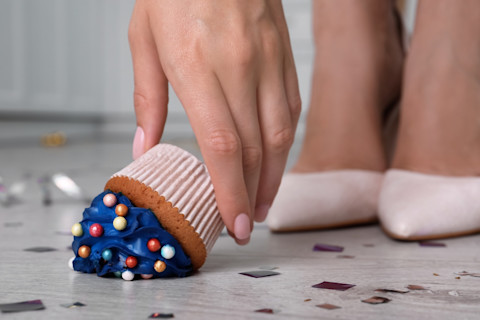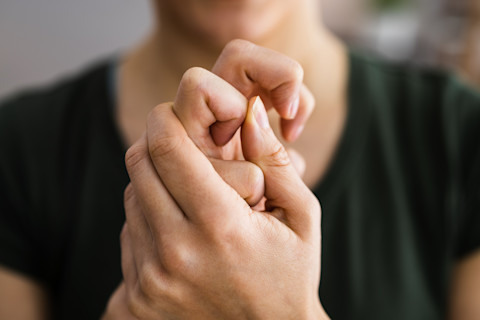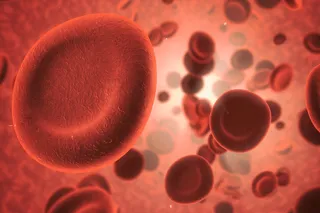If you swallow a piece of gum, it will stay in your stomach for seven years. Dropping food on the floor is okay to eat if it’s been less than five seconds. Cracking your knuckles is bad and can lead to arthritis and other joint problems. Do these sayings ring a bell? Maybe you’ve heard them growing up, or continue to hear them from kids, or adults, today. So, are these old-time sayings true? Here’s what experts and recent studies reveal.
1. Is the Five-Second Rule True?

(Credit: New Africa/Shutterstock)
New Africa/Shutterstock
You drop a piece of candy on the floor and pick it up. “It was less than five seconds,” you say, as you pop it in your mouth. While the five second rule is a common saying and rule people tend to abide by, Ganga Moorthy, an assistant professor of pediatric infectious disease at Duke University, says it’s a complicated thing to advise people on.
There's no doubt bacteria and viruses are all around us, and as soon as something hits the floor – or any surface – there’s a risk of contamination, Moorthy explains. To complicate things further, Moorthy adds how bacteria and viruses can live on different surfaces for different times, and some foods seem to attract microorganisms more easily than others. For example, foods that have more moisture – such as fruits like apples and watermelons – appear to get contaminated faster than foods with less moisture, Moorthy says.
This 2016 study published in the Applied and Environmental Microbiology journal backs this up. When comparing watermelon, gummy candy, and bread (with and without butter), researchers found overall watermelon had the greatest number of bacteria transferred, while gummy candy had the least amount. Researchers also found the surface mattered too. For example, carpet transferred the least number of bacteria, while tile and stainless steel had higher transfer rates in this study utilizing one specific bacterium. As the researchers concluded, “longer food contact times usually resulted in the transfer of more bacteria from each surface to food.”
Read More: What Are Ultra-Processed Foods: Can They Affect Your Mental Health?
Still, your safest bet to completely avoid microorganisms is, yes, to not eat the food that hits the floor, says Moorthy. Of course, this isn’t always practical. Also, “completely sterile environments aren't good for kids,” Moorthy explains, adding how exposure to various bacteria and viruses helps build their immune system and aids in their development.
“I don't think there's a definitive answer that fits every family about the five second rule,” Moorthy says. Still, the most important consideration when contemplating whether to eat the food after a drop is if you or your child has a health condition or risk factors that makes you or your child more prone to infection.
Other factors to consider when your food drops on a surface are how often you’re cleaning (and with what types of products, as some bacteria and viruses require a stronger cleaner to sanitize properly), and for example, if shoes are worn inside or not. If you aren’t in your home, you might also ponder about the cleanliness of the environment overall. Though Moorthy emphasizes how “a visibly dirty floor is clearly dirty, but a non-visibly dirty floor isn't necessarily clean.”
Just know, “the less amount of time something is sitting on the floor, the lower your risk of contamination. But five seconds is certainly not equal to zero germs,” Moorthy explains.
2. What Happens if you Swallow Gum?

(Credit: Olena Yakobchuk/Shutterstock)
Olena Yakobchuk/Shutterstock
“It's definitely an old wives tale that you shouldn't swallow your gum because it'll stay in you for years and rot in your intestines,” says Irene Sonu, clinical associate professor of gastroenterology and hepatology at Stanford University School of Medicine. While Sonu doesn’t work directly with children in her practice, her own children have asked her if it’s true and tells them, “It’s not true.”
“There are components of gum that are probably absorbed by our digestive tracts and broken down and absorbed, and then there are elements that are more non-absorbed — kind of just in the same way fiber isn’t absorbed, and then you just poop it out,” Sonu explains.
Now if you swallow a lot of gum at once, like this case study of a five-year-old boy who swallowed an entire pack of gum, this could lead to abnormal gastrointestinal symptoms and possible problems. So yes, swallowing a large amount of gum isn’t advised. Gum is indeed meant to be chewed and not swallowed.
Sonu admits she has yet to see gum inside someone's gastrointestinal tract, though there are extremely rare cases where gum is visualized (like this patient who admitted to swallowing about 25 pieces of nicotine gum per day over the past three years.)
If you, or your children, swallow a piece or two of gum on accident though, don’t panic. As Sonu says, “[The gum] will come out eventually,” and it should do so without any problems.
Read More: Why Walking Might Be One of the Best Exercises For Health
3. Is Cracking Your Knuckles Bad for You?

(Credit: Andrey_Popov/Shutterstock)
Andrey_Popov/Shutterstock
Do you crack your knuckles – or your finger joints — often? According to researchers of this 2017 study published in the Clinical Orthopaedics and Related Research journal, “voluntary knuckle cracking is a common habit, with a reported prevalence of 25% to 45%.”
While knuckle cracking can be a nervous habit, and one that may be disturbing to others, Michael Fredericson, professor and director of the Physical Medicine & Rehabilitation Sports Medicine program at Stanford University, says “there's no research to suggest that it will lead to arthritis.”
Still, researchers continue to study the impacts of doing so. In the 2017 study above, researchers set out to find out if knuckle-crackers compared to non-knuckle crackers experience more swelling, weakness, joint laxity, or differences in range of motion.
Though a small sample size, the researchers didn’t find differences in swelling, strength, or joint laxity. What they found is knuckle crackers had a small increase in range of motion in the joints that cracked. As Fredericson says, you, or someone around you, might be doing this because you “feel a little bit looser.”
“The cracking of your joints, per se, isn't harmful. I think if you do it repeatedly, it could lead to some laxity of the ligaments around the joints, and that wouldn’t be healthy. But you'd really have to sort of overdo it, you know?” Fredericson adds.















